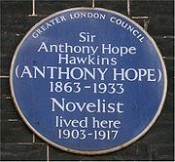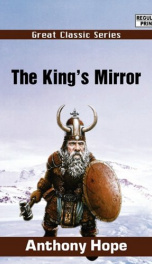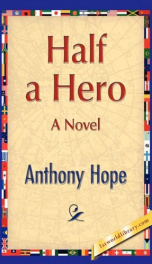Hope Anthony

Sir Anthony Hope Hawkins, better known as Anthony Hope (9 February 1863 – 8 July 1933), was an English novelist and playwright. Although he was a prolific writer, especially of adventure novels, he is remembered best for only two books: The Prisoner of Zenda (1894) and its sequel Rupert of Hentzau (1898). These works, "minor classics" of English literature,[1] are set in the contemporaneous fictional country of Ruritania and spawned the genre known as Ruritanian romance. Zenda has inspired many adaptations, most notably the 1937 Hollywood movie of the same name. Hope was born in Clapton, then on the edge of London, where his father, the Reverend Edward Connerford Hawkins, was headmaster of St John's Foundational School for the Sons of Poor Clergy (now renamed St John's School, Leatherhead and moved out of London).[2] Hope's mother, Jane Isabella Grahame, was an aunt of Kenneth Grahame, the author of Wind in the Willows. Hope was educated by his father and then attended Marlborough College, where he was editor of The Marlburian.[2] He won a scholarship to Balliol College at Oxford University in 1881. Before graduating in 1886, he played football for his college, took a first class degree in Classics, and was one of the rare Liberal presidents of the Oxford Union, becoming known as a good speaker. His contemporaries included Cosmo Gordon Lang, later Archbishop of Canterbury; A.E.W. Mason, author of The Four Feathers; Arthur Quiller-Couch, a literary critic; Gilbert Murray, a classical scholar and intellectual; Sir Michael Sadler, an historian and educationalist; and J. A. Spender, editor of the Westminster Gazette. Hope trained as a lawyer and barrister, being called to the Bar by the Middle Temple in 1887. He had time to write, as his working day was not overly full during these first years, and he lived with his widowed father, then vicar of St Bride's Church, Fleet Street. Hope's short pieces appeared in periodicals, but for his first book he was forced to resort to a vanity press. A Man of Mark (1890) is notable primarily for its similarities to Zenda: it is set in an imaginary country, Aureataland, and features political upheaval and humour. More novels and short stories followed, including Father Stafford in 1891 and the mildly successful Mr Witt's Widow in 1892. In 1893 he wrote three novels (Sport Royal, A Change of Air and Half-a-Hero)[2] and a series of sketches that first appeared in the Westminster Gazette and were collected in 1894 as The Dolly Dialogues, illustrated by Arthur Rackham. Dolly was his first major literary success. A.E.W. Mason deemed these conversations "so truly set in the London of their day that the social historian would be unwise to neglect them" and said they were written with "delicate wit [and] a shade of sadness."[3] The idea for Hope's tale of political intrigue, The Prisoner of Zenda, being the history of three months in the life of an English gentleman, came to him at the close of 1893 as he was walking in London. Hope finished the first draft in a month, and the book was in print by April. The story is set in the fictional European kingdom of 'Ruritania', a term which has come to mean 'the novelist's and dramatist's locale for court romances in a modern setting.'[4] Zenda achieved instant success, and its witty protagonist, the debonair Rudolf Rassendyll, became a well-known literary creation. The novel was praised by Mason, the literary critic Andrew Lang, and Robert Louis Stevenson.[5] The popularity of Zenda convinced Hope to give up the "brilliant legal career [that] seemed to lie ahead of him"[6] to become a full-time writer, but he "never again achieved such complete artistic success as in this one book."[7] Also in 1894, Hope produced The God in the Car, a political story.[2] The sequel to Zenda, Rupert of Hentzau, begun in 1895 and serialised in the Pall Mall Magazine, did not appear between hard covers until 1898. A prequel entitled The Heart of Princess Osra, a collection of short stories set about 150 years before Zenda, appeared in 1896. Hope also co-wrote, with Edward Rose, the first stage adaptation of Zenda, which appeared on the London stage that year. Hope alone wrote the dramatic adaptation of Rupert of Hentzau in 1899. Hope wrote 32 volumes of fiction over the course of his lifetime, and he had a large popular following. In 1896 he published The Chronicles of Count Antonio, followed in 1897 by a tale of adventure set on a Greek island, entitled Phroso.[2] He went on a publicity tour of the United States in late 1897, during which he impressed a New York Times reporter as being somewhat like Rudolf Rassendyll: a well-dressed Englishman with a hearty laugh, a soldierly attitude, a dry sense of humour, "quiet, easy manners" and an air of shrewdness.[8] In 1898, he wrote Simon Dale, an historical novel involving the actress and courtesan Nell Gwyn. Marie Tempest appeared in the dramatisation, called English Nell. One of Hope's plays, The Adventure of Lady Ursula, was produced in 1898. This was followed by his novel The King's Mirror (1899), which Hope considered one of his best works. In 1900, he published Quisanté, and he was elected chairman of the committee of the Society of Authors. He wrote Tristram of Blent in 1901 and Double Harness in 1904, followed by A Servant of the Public in 1905, about the love of acting. In 1906, he produced Sophy of Kravonia, a novel in a similar vein to Zenda; Roger Lancelyn Green is especially damning of this effort.[9] In 1910, he wrote Second String, followed by Mrs Maxon Protests the next year. In addition, Hope wrote or co-wrote many plays and some political non-fiction during the Great War, some under the auspices of the Ministry of Information. Later publications included Beaumaroy Home from the Wars, in 1919, and Lucinda in 1920. Lancelyn Green asserts that Hope was "a first-class amateur but only a second-class professional writer."[1] Hope married Elizabeth Somerville (1885/6–1946) in 1903, and they had two sons and a daughter. He was knighted in recognition of his contribution to propaganda efforts during World War I. He published an autobiographical book, Memories and Notes, in 1927. Hope died of throat cancer at the age of 70. There is a blue plaque on his house in Bedford Square, London.
do you like this author?
What readers are saying
What do you think? Write your own comment on this book!
write a commentWhat readers are saying
What do you think? Write your own comment on this author!
write a commentBook list

Tristram of BlentAn Episode in the Story of an Ancient House
Series:
Unknown
Year:
Unknown
Raiting:
3/5
Show more
add to favoritesadd In favorites

The Indiscretion of the Duchess
Being a Story Concerning Two Ladies,a Nobleman,and a Necklace
Series:
Unknown
Year:
Unknown
Raiting:
4.5/5
Show more
add to favoritesadd In favorites

Tristram of Blent
Series:
Unknown
Year:
Unknown
Raiting:
2.5/5
Sir Anthony Hope Hawkins, better known as Anthony Hope, (1863-1933) was a British novelist and playwright best remembered today for his short novel The Prisoner of Zenda (1894), a prequel The Heart of Princess Osra (a collection of short stories) (1896), and a sequel Rupert of Hentzau (1898). These works were all set in the contemporaneous fictional kingdom of Ruritania. His first novel was A Man of Mark (1890), and one of his most well-known works during his lifetime was The Dolly Dialogues (1894), published in the Westminster Gazette. He started writing full time after Zenda's success, completing many other novels and plays, including English Nell (based on the life of actress Nell Gwyn), and Sophy of Kravonia (1906), in a similar vein as the Zenda story. He was knighted in recognition of his contribution to British propaganda efforts during World War I. He also published an autobiographical book, Memories and Notes, in 1927. His other works include: Father Stafford (1891), Half a Hero (1893), The Indiscretion of the Duchess (1894), Frivolous Cupid (1895), The King's Mirror (1899), and Quisanté (1900).
Show more
add to favoritesadd In favorites

Simon Dale
Series:
Unknown
Year:
Unknown
Raiting:
4.5/5
Purchase of this book includes free trial access to www.million-books.com where you can read more than a million books for free. This is an OCR edition with typos. Excerpt from book: CHAPTER EL The Music of the World. If a philosopher, learned in the human mind as Flamsteed in the courses of the stars or the great Newton in the laws of external nature, were to take one possessed by a strong passion of love or a bitter grief or what overpowering emotion you will, and were to consider impartially and with cold precision what share of his time was in reality occupied by the thing .which, as we are in the habit of saying, filled his thoughts or swayed his life or mastered his intellect, the world might well smile (and to my thinking had better smile than weep) at the issue of the investigation. When the first brief shock was gone, how few out of the solid twenty-four would be the hours claimed by the despot, however much the poets might call him insatiable. There is sleeping, and meat and drink, the putting on and off of raiment and the buying of it. If a man be of sound body, there is his sport; if he be sane there are the interests of this life and provision for the next. And if he be young, there is nature's own joy in living which with a patient scornful smile sets aside his protest that he is vowed to misery and makes him, willynilly, laugh and sing. So that, if he do not drown himself in a week and thereby baulk the enquiry, it is odds that he will compose himself in a month and by the end of a year will carry no more marks of his misfortune than (if he be a man of good heart) an added sobriety and tenderness of spirit.Yet all this does not hinder the thing from returning, on occasion given. In my own caseand if my story be followed to its close I am persuaded that I shall not be held to be one who took the disease of love more lightly than my fellowsthis process of convalescence, most salutary, yet in a sense humiliating, was aided by a train of ci...
Show more
add to favoritesadd In favorites

The Secret of the Tower
Series:
Unknown
Year:
Unknown
Raiting:
0.5/5
This volume is produced from digital images created through the University of Michigan University Library's preservation reformatting program. The Library seeks to preserve the intellectual content of items in a manner that facilitates and promotes a variety of uses. The digital reformatting process results in an electronic version of the text that can both be accessed online and used to create new print copies. This book and thousands of others can be found in the digital collections of the University of Michigan Library. The University Library also understands and values the utility of print, and makes reprints available through its Scholarly Publishing Office.
Show more
add to favoritesadd In favorites

The King's Mirror
Series:
Unknown
Year:
Unknown
Raiting:
3.5/5
Sir Anthony Hope Hawkins, better known as Anthony Hope, (1863-1933) was a British novelist and playwright best remembered today for his short novel The Prisoner of Zenda (1894), a prequel The Heart of Princess Osra (a collection of short stories) (1896), and a sequel Rupert of Hentzau (1898). These works were all set in the contemporaneous fictional kingdom of Ruritania. His first novel was A Man of Mark (1890), and one of his most well-known works during his lifetime was The Dolly Dialogues (1894), published in the Westminster Gazette. He started writing full time after Zenda's success, completing many other novels and plays, including English Nell (based on the life of actress Nell Gwyn), and Sophy of Kravonia (1906), in a similar vein as the Zenda story. He was knighted in recognition of his contribution to British propaganda efforts during World War I. He also published an autobiographical book, Memories and Notes, in 1927. His other works include: Father Stafford (1891), Half a Hero (1893), The Indiscretion of the Duchess (1894), Frivolous Cupid (1895), The King's Mirror (1899), and Quisanté (1900). --This text refers to an alternate Paperback edition.
Show more
add to favoritesadd In favorites

Half a Hero
Series:
Unknown
Year:
Unknown
Raiting:
4.5/5
In the garden the question was settled without serious difference of opinion. If Sir Robert Perry really could not go on-and Lady Eynesford was by no means prepared to concede even that-then Mr. Puttock, bourgeois as he was, or Mr. Coxon, conceited and priggish though he might be, must come in. At any rate, the one indisputable fact was the impossibility of Mr. Medland: this was, to Lady Eynesford's mind, axiomatic, and, in the safe privacy of her family circle (for Miss Scaife counted as one of the family, and Captain Heseltine and Mr. Flemyng did not count at all), she went so far as to declare that, let the Governor do as he would (in the inconceivable case of his being so foolish as to do anything of the kind), she at least would not receive Mr. Medland. Having launched this hypothetical thunderbolt, she asked Alicia Derosne to give her another cup of tea. Alicia poured out the tea, handed it to her sister-in-law, and asked,
Show more
add to favoritesadd In favorites

Frivolous Cupid
Series:
Unknown
Year:
Unknown
Raiting:
3/5
Anthony Hope is the pseudonym of Sir Anthony Hope Hawkins, author of "The Prisoner of Zenda".
Show more
add to favoritesadd In favorites

Father Stafford
Series:
Unknown
Year:
Unknown
Raiting:
4.5/5
This volume is produced from digital images created through the University of Michigan University Library's preservation reformatting program. The Library seeks to preserve the intellectual content of items in a manner that facilitates and promotes a variety of uses. The digital reformatting process results in an electronic version of the text that can both be accessed online and used to create new print copies. This book and thousands of others can be found in the digital collections of the University of Michigan Library. The University Library also understands and values the utility of print, and makes reprints available through its Scholarly Publishing Office.
Show more
add to favoritesadd In favorites
What readers are saying
What do you think? Write your own comment on this author!
write a commentif you like Hope Anthony try:
readers also enjoyed
What readers are saying
What do you think? Write your own comment on this author!
write a commentGenre
if you like Hope Anthony try:
readers also enjoyed
Do you want to exchange books? It’s EASY!
Get registered and find other users who want to give their favourite books to good hands!

